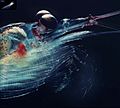Antarctic krill facts for kids
Quick facts for kids Antarctic krill |
|
|---|---|
 |
|
| Scientific classification | |
| Kingdom: | |
| Phylum: | |
| Subphylum: | |
| Class: | |
| Order: | |
| Family: | |
| Genus: |
Euphausia
|
| Species: |
E. superba
|
| Binomial name | |
| Euphausia superba Dana, 1850
|
|
Antarctic krill (Euphausia superba) are small, shrimp-like animals that live in the icy Antarctic waters of the Southern Ocean. They are invertebrates, which means they do not have a backbone.
These amazing creatures often live in huge groups called swarms. Sometimes, these swarms are so dense that there can be 10,000 to 30,000 krill in just one cubic meter of water!
Krill eat tiny plant-like organisms called phytoplankton. Phytoplankton get their energy from the sun. By eating phytoplankton, krill use that same energy to live in the open ocean. Antarctic krill can grow up to 6 cm long and weigh about 2 g. They can live for up to six years.
Krill are a very important part of the Antarctic ecosystem. In fact, they are probably the most successful animal species on Earth when it comes to their total weight, or biomass. All the Antarctic krill together weigh about 500 million tonnes!
Sometimes, when krill are kept in aquariums, they have been seen eating each other.
Contents
What are Antarctic Krill?
Antarctic krill are small creatures that look a lot like tiny shrimp. They are part of a group of animals called crustaceans, which also includes crabs and lobsters. Unlike fish or mammals, krill do not have bones inside their bodies. Instead, they have a tough outer shell.
Krill are known for living in massive groups called swarms. These swarms can be so big that they stretch for miles and are even visible from space! Living in such large groups helps krill protect themselves from predators.
Where do Krill Live?
Antarctic krill live only in the very cold waters around Antarctica. This area is known as the Southern Ocean. They are found in different parts of this ocean, often near the ice.
The Southern Ocean provides the perfect home for krill. It has plenty of the tiny plants they love to eat. The cold temperatures also help them thrive.
What do Krill Eat?
Antarctic krill are herbivores, meaning they eat plants. Their main food source is phytoplankton. These are microscopic plants that float in the ocean and use sunlight to make their own food, just like plants on land.
Krill have special basket-like legs that they use to filter these tiny plants from the water. They are like living sieves, constantly straining the ocean for their next meal.
Why are Krill Important?
Antarctic krill are a "key species" in their ecosystem. This means they are super important to the survival of many other animals. They are a major food source for almost all the larger animals in the Southern Ocean.
Many animals depend on krill for food. These include whales, seals, penguins, squid, and many types of fish. Without krill, the entire food web in the Antarctic would collapse. This makes krill vital for the health of the planet's oceans.
Images for kids
-
The head of Antarctic krill. Observe the bioluminescent organ at the eyestalk and the nerves visible in the antennae, the gastric mill, the filtering net at the thoracopods and the rakes at the tips of the thoracopods.
-
Krill distribution on a NASA SeaWIFS image – the main concentrations are in the Scotia Sea at the Antarctic Peninsula
-
Annual world catch of E. superba, compiled from FAO data.
See also
 In Spanish: Kril antártico para niños
In Spanish: Kril antártico para niños









